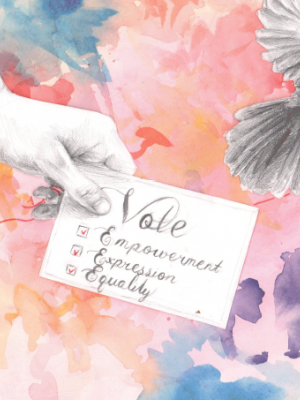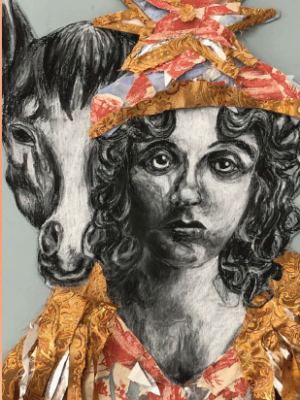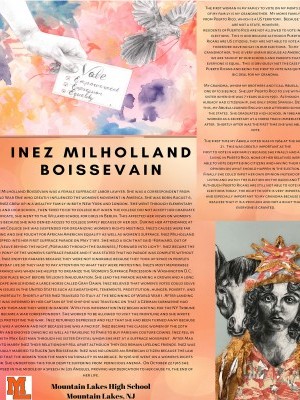Elliott Smith, Gabriel Maute, Judy Xie, Daniela Liang, Livia Ludlam
Mountain Lakes High School | Mountain Lakes, NJ | 11th Grade
Inspirational Family Member
My Abuela
The first woman in my family to vote on my mom’s side is my grandmother. My mom’s family is from Puerto Rico which is a US territory. Because they are not a state however, residents of Puerto Rico are not allowed to vote in our elections. This is odd because although Puerto Ricans are US citizens, they are not able to vote and therefore have no say in our elections. To my grandmother, this is very unfair because as Americans we are taught by our schools and parents that everyone is equal. This is obviously not the case for Puerto Ricans and being the first to vote was quite a big deal for my grandma.
The first time my Abuela voted was in 1964 at the age of 21. This was greatly important as the first to vote in her family because she finally had a say. Living in Puerto Rico, none of her relatives were able to vote despite being citizens and having their own opinion on what should happen in the election. Finally she could input her own opinion instead of just listen and watch the election on the radio and TV. Although Puerto Ricans are still not able to vote in the elections today, the right to vote is very important and especially important to my grandma because she realizes that it is a privilege and not a right that everyone is granted.
My grandma, who my brothers and I call Abuela, was one of 10 siblings. She left Puerto Rico to live with her sister when she was 7 years old in 1950. Although she already had citizenship, she only spoke Spanish. Despite this, my abuela learned English and attended school in the states. She graduated High School in 1963 and worked as a secretary at a horse track immediately after. Shortly after was the first time she was able to vote.
Historical Figure I Admire
Inez Milholland Boissevain
Inez Milholland Boissevain was a female suffragist labor lawyer. She was a correspondent from World War One who greatly influenced the women’s movement in America. Inez grew up in a wealthy family in both New York and London. She was born August 6, 1886. She went through elementary school and high school, then tried to go to college but when the college did not accept her graduate certificate, she went to the Willard school for girls in Berlin. This affected her views on women’s rights because she was denied access to college simply because of her sex.
During her attendance at Vassar College she was suspended for organizing women’s rights meetings. Inez’s causes were far reaching and she fought for African American equality as well as women’s suffrage. Inez Milholland stepped into her first suffrage parade on May 7, 1911. She held a sign that said “Forward, out of error,/Leave behind the night,/Forward through the darkness,/ Forward into light!”. Inez became the “show pony” of the women’s suffrage parade and it was stated that no parade was complete without her. Inez enjoyed parades because they were not ignorable because they took up space in people’s everyday life so they had to pay attention to what they were protesting. Inez’s most memorable appearance was when she helped to organize the Women’s Suffrage Procession in Washington D.C. This took place right before Wilson’s Inauguration. She led the parade wearing a crown and a long white cape while riding a large horse called Gray Dawn. Inez believed that women’s votes could solve certain issues in the United States such as sweatshops, tenements, prostitution, hunger, poverty, and child mortality.
Shortly after, Inez traveled to Italy at the beginning of World War 1. After landing she was informed by her captain of the ship she was traveling on, that a German submarine had followed them and they were in danger. With this information Inez began writing for the NY Tribune and became a war correspondent. She worked to be allowed to visit the frontline and she wrote articles protesting the war. Inez returned depressed and felt that she had been turned away because she was a woman and not because she was a pacifist. Inez became the classic woman of the 20th century and enjoyed dancing as well as traveling to Paris to buy Parisian couture gowns. Inez fell in love with Max Eastman through his sister, Crystal, whom she met at a suffrage movement. After Max agreed to marry Inez, their relationship fell apart although they did remain lifelong friends. Inez was eventually married to Eugen Jan Boissevain. Inez was no longer an American citizen because the law stated that the women took the man’s nationality in marriage. In 1916 she went on a women’s rights tour. She undertook this tour despite suffering from pernicious anemia. On October 22, 1916, she collapsed in the middle of a speech in Los Angeles, proving her dedication to her cause til the end of her life.
What the Project Means to Me
The first time my Abuela voted was in 1964 at the age of 21. This was greatly important as the first vote in her family because she actually had a say. Living in Puerto Rico, none of her relatives were able to vote despite being citizens and having their own opinion on what should happen in the election. Finally, she could input her own opinion instead of just listen and watch the election on the radio and TV. Although Puerto Ricans are still not able to vote in the elections today, the right to vote is very important and especially important to my grandma because the realizes that it is a privilege and not a right that everyone is granted.
Explore the Archive
Deadline Extended
There's still time to join Women Leading the Way.
Become a part of our storytelling archive. Enroll your class today.
Join the Project



